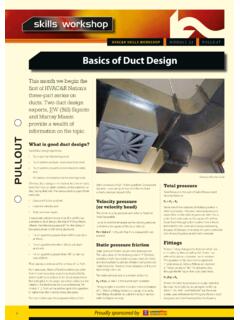Transcription of CHAPTER 48. NOISE AND VIBRATION CONTROL - tsvibra.ir
1 CHAPTER 48. NOISE AND VIBRATION CONTROL hvac equipment for a building is one of the major sources of interior NOISE , and its effect on the acoustical environment is important. Further, NOISE from equipment located outdoors often propagates to the community. Therefore, mechanical equipment must be selected, and equipment spaces designed, with an emphasis on both the intended uses of the equipment and the goal of providing acceptable sound levels in occupied spaces of the building and in the surrounding community. Operation of hvac equipment can also induce mechanical VIBRATION that propagates into occupied spaces through structureborne paths such as piping, ductwork, and mounts.
2 VIBRATION can cause direct discomfort and also create secondary radiation of NOISE from vibrating walls, floors, piping, etc. In this CHAPTER , sound and NOISE are used interchangeably, although only unwanted sound is considered to be NOISE . System analysis for NOISE CONTROL uses the source-path-receiver concept. The source of the sound is the NOISE -generating mechanism. The sound travels from the source via a path, which can be through the air (airborne) or through the structure (structureborne), or a combination of both paths, until it reaches the receiver (building occupant or outdoor neighbor).
3 Components of the mechanical system ( , fans, dampers, diffusers, duct junctions) all may produce sound by the nature of the airflow through and around them. As a result, almost all hvac components must be considered. Because sound travels effectively in the same or opposite direction of airflow, downstream and upstream paths are often equally important. This CHAPTER provides basic sound and VIBRATION principles and data needed by hvac system designers. Many of the equations associated with sound and VIBRATION CONTROL for hvac may be found in CHAPTER 8 of the 2009 ASHRAE Handbook fundamentals .
4 Additional technical discussions along with detailed hvac component and system design examples can be found in the references. DATA RELIABILITY Data in this CHAPTER come from both consulting experience and research studies. Use caution when applying the data, especially for situations that extrapolate from the framework of the original research. Test data tolerances and cumulative system effects lead to a typical uncertainty of 2 dB. However, significantly greater variations may occur, especially in low frequency ranges and particularly in the 63 Hz octave band, where experience suggests that even correctly performed estimates may disagree with actual measured levels by 5 dB, so conservative design practices should be followed.
5 ACOUSTICAL DESIGN OF hvac SYSTEMS For most hvac systems, sound sources are associated with the building s mechanical and electrical equipment. As shown in Figure 1, there are many possible paths for airborne and structureborne sound and VIBRATION transmission between a sound source and receiver. NOISE CONTROL involves (1) selecting a quiet source, (2) optimizing room sound absorption, and (3) designing propagation paths for minimal NOISE transmission. Figure 1. Typical Paths of NOISE and VIBRATION Propagation in hvac Systems Figure 2.
6 hvac Sound Spectrum Components for Occupied Spaces Figure 3. Frequency Ranges of Likely Sources of Sound-Related Complaints (Schaffer 2005) Figure 4. Frequencies at Which Different Types of Mechanical Equipment Generally CONTROL Sound Spectra(Schaffer 2005) Different sources produce sounds that have different frequency distributions, called spectral characteristics. For example, as shown in Figure 2, fan NOISE generally contributes to sound levels in the 16 to 250 Hz octave bands (curve A). [Frequencies that designate the octave bands are often called octave midband (or center) frequencies.]
7 ] Variable-air-volume (VAV) valve NOISE usually contributes to sound levels in the 63 to 1000 Hz octave bands (curve B). Diffuser NOISE usually contributes to the overall hvac NOISE in the 250 to 8000 Hz octave bands (curve C). The overall sound pressure level associated with all of these sound sources combined is shown as curve D. Figure 3 (Schaffer 2005) shows the frequency ranges and descriptive terminology of the most likely sources of hvac sound-related complaints. Figure 4 (Schaffer 2005) shows the frequencies at which different types of mechanical equipment generally CONTROL the sound spectra in a room.
8 Occupant complaints may occur, however, despite a well-designed sound spectrum in the room. Criteria specified in this CHAPTER do not necessarily correspond with all individuals acceptability criteria. RECEIVER CONSIDERATIONS Indoor Sound Criteria Whether an occupant considers the background NOISE acceptable generally depends on two factors. First is theperceived loudness of the NOISE relative to that of normal activities; if it is clearly noticeable, it is likely to be distracting and cause complaint. Second is the sound quality of the background NOISE ; if the NOISE is perceived as a rumble, throb, roar, hiss, or tone, this may result in complaints of annoyance and stress.
9 The frequency spectrum is then said to be unbalanced. The acoustical design must ensure that hvac NOISE is of sufficiently low level and unobtrusive quality so as not to interfere with occupancy use requirements. If background NOISE reduces speech intelligibility, for example, complaints of lost productivity can result. Accordingly, methods of rating hvac -related NOISE ideally assess both perceived loudness and sound quality. Design Guidelines for hvac -Related Background Sound in Rooms. Table 1 presents recommended goals for indoor background NOISE levels in various types of unoccupied rooms served by hvac systems.
10 Perceived loudness and task interference are factored into the numerical part of the rating. The sound quality design target is assumed to be a neutral-sounding spectrum, although some spectral imbalance is probably tolerable within limits for most users. The criteria used are described in the next section. An acceptable NOISE level depends on the specific use of the space, so each number rating typically represents a range of 5 dB for the design target. For example, private offices and conference rooms are listed as NC/RC 30.

